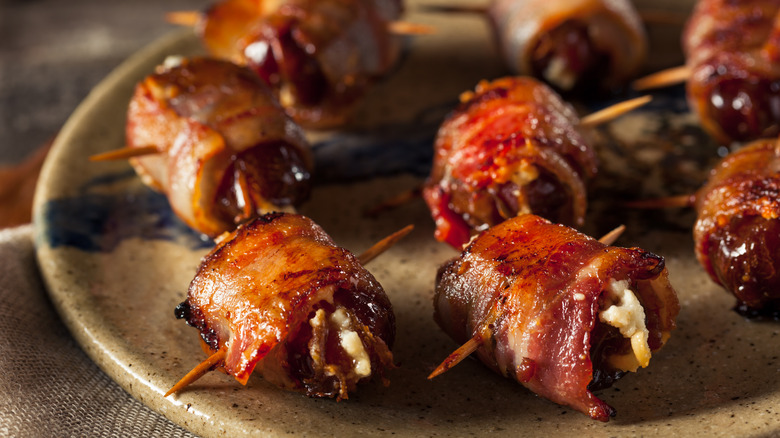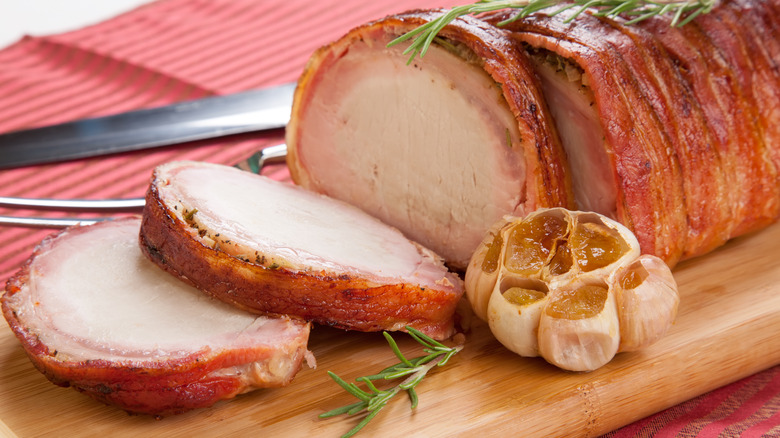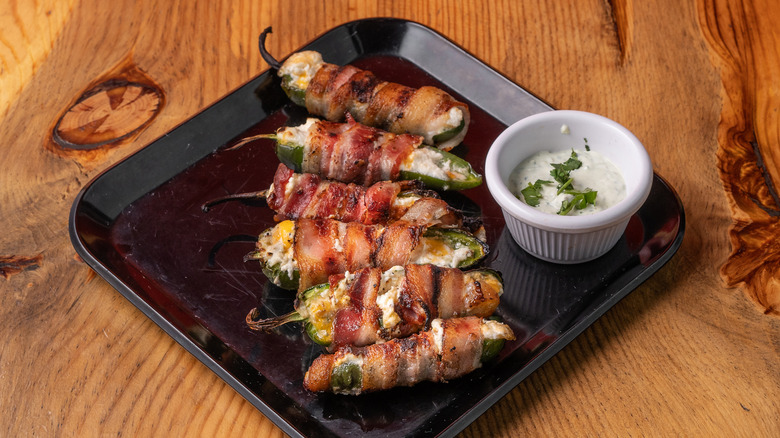The Best Bacon To Use For Wrapping Anything From Fruit To Seafood
Salty, smoky, crispy, and chewy bacon can dress up just about any dish, and you have a wide variety of types to choose from. However, not just any kind of bacon will do for any recipe. If you use the wrong kind for a certain purpose, you might wind up with an undesirable taste or texture. When it comes to wrapping foods in bacon, from dates to asparagus to scallops, stick to thin strips. Bacon labeled "thin-cut" usually measures about 1/32 of an inch thick.
The name of the game when bacon-wrapping foods is rendering. As bacon cooks, the fat slowly melts out, sizzling the strips and causing them to turn crisp. The result is meat that is both crunchy and chewy (and if you're wise, you'll conserve the fat for a bacon grease stash). The most important factor to remember is that this process takes some time, and thick-cut bacon (typically sliced around 1/8 inch thick) takes much longer to cook. This can cause all sorts of issues, if the item you're wrapping cooks in a shorter time than the bacon itself.
Meaty British, English, or Irish back bacon — also called rashers — would also be a no-go for this purpose. And you'll want to use raw bacon to wrap up your dishes, too. The pre-cooked stuff is better reserved for quick breakfasts.
What type of bacon to use for wrapping small and large items
When you're wrapping small ingredients, like shrimp, scallops, asparagus, bunches of green beans, or even smaller steaks or chicken breasts, they'll cook through relatively quickly. In the time it would take for the fat to fully render out of thick-cut bacon, the inner ingredient will be completely overcooked. Meanwhile, if you stop cooking as soon as these smaller items are done, the bacon will still be floppy, gristly, and unappetizing. And if you're making bacon-wrapped watermelon or using another juicy fruit or veggie, it can be even harder for thick bacon's fat to get hot enough.
This is why thin-sliced bacon is a must, as it crisps up in a jiffy. Aside from any packages labeled with the word "thin" in some form, you can also look for restaurant-style bacon, which tends to be thinner. Items that take longer to cook — like a beef tenderloin, pork chops, whole potatoes, or meatloaf — can withstand a slightly thicker cut. If you want a meatier feel, go for bacon slices labeled as regular, standard, or traditional, though a thin cut will still work for these dishes. You just want to avoid hearty slices, as the thicker the strip, the less crispy it will be when used for wrapping.
Tips for wrapping anything in bacon
Using thin-cut bacon for wrapping is a good start, but there are other ways to make mistakes and wind up with fat that hasn't rendered enough. Keeping your bacon in a single layer, or as close to that as possible, will really help. For structural integrity, you probably have to overlap the bacon a little as you roll it up, especially for gooey cheese dishes like goat cheese-stuffed figs or jalapeño poppers. However, overlapping too much or layering two strips of bacon together will yield results that are more stringy and chewy than crisp.
Cutting each strip to size can help you achieve the most even wrapping. A pair of kitchen shears works great for this task. Wrap up one of your items in a strip of bacon, snip off the excess, and then use that strip as your measuring guide. Something like Southern bacon-wrapped crackers may only use a half a strip or less, while bacon-wrapped onion rings will typically need a full slice.
You can also use a toothpick or kitchen twine to secure the strip once you're done wrapping. If using toothpicks, make sure to use exactly the same number per piece or portion, so that you know how many to remove once the dish is done cooking. Cooking your food with the seam side down is another way to keep a bacon wrapping in place, with less of risk of unravelling.



